Topic: Pitches Store Archaeological Dig
Topic type:
Collection of artefacts re-discovered from around Pitches Store, Ophir.
Pitches’ Store Ophir Archæological Site G41/614 Archæological Excavation
Archæological Authority 2008/338
P.G. Petchey Southern Archæology
2011
Pitches Store Archæology 1
Table of Contents
Introduction................................................................................................................2 Legal description........................................................................................................2 Development Proposal...............................................................................................2 History of Ophir.........................................................................................................4 History of Pitches’ Store............................................................................................6 Site Description........................................................................................................10 Building Modifications Over Time..........................................................................13 Archæological Excavation.......................................................................................14 Area 1...................................................................................................................17 Areas 2 & 4..........................................................................................................17 Area 3...................................................................................................................18 Area 5...................................................................................................................22 Artefact Analysis .....................................................................................................23 Glassware.............................................................................................................23 Ceramics ..............................................................................................................25 Ceramic Makers’ Marks ......................................................................................28 Clay Pipe..............................................................................................................31 Ceramic Figurine .................................................................................................31 Metalware ............................................................................................................32 Faunal Material....................................................................................................36 Discussion................................................................................................................37 References................................................................................................................39 Maps & Plans...........................................................................................................39 Websites...................................................................................................................39 Appendix A..............................................................................................................40 New Zealand Archæological Association Site Record Form..............................40 Appendix B..............................................................................................................41 Artefact Catalogue...............................................................................................41
Archæological Excavation of Pitches’ Store, Ophir
Introduction
Pitches’ Store building is an historic nineteenth century stone commercial building on Swindon Street, Ophir (Figures 1 & 2). It is at the time of writing empty, but its owners, David & Colleen Hurd, are undertaking the restoration and redevelopment of the building for use as a restaurant/bar and accommodation. In June 2011 an archæological investigation was undertaken behind the building as part of the planning work for this development, under Archæological Authority No. 2008/338 issued by the Historic Places Trust. It is known from historic photographs that the store building was once nearly twice the size that it appeared by the early 21st Century, and a 2008 archæological assessment of the site (Petchey 2008) identified the level grassed area behind the surviving stone store as being highly likely to contain archæological evidence of the missing section of the building. As a result, one of the conditions of the Archæological Authority was that this area should be investigated prior to redevelopment work commencing. The excavation work and this report were commissioned by Michael Wyatt Architect Ltd. on behalf of Hurd Property Partnership.
Legal description
The store building is located on Section 5 Block II Town of Ophir (see Figures 2 & 3). The neighbouring Section 4 is also part of the development proposal.
Pitches’ Store is registered by the New Zealand Historic Places Trust as a Category II historic place (Reg. No. 7282), and is recorded as an archæological site on the New Zealand Archæological Association Site Record File (site G41/614).
Development Proposal
The owners intend to develop a restaurant/bar and accommodation business in the building. The development proposal involves the restoration of the façade and roofline of the store back to the original design, the construction of an extension to the rear of the building (of about the same size as the extensions that once existed, the foundations of which are described in this report), and landscaping to the grounds.
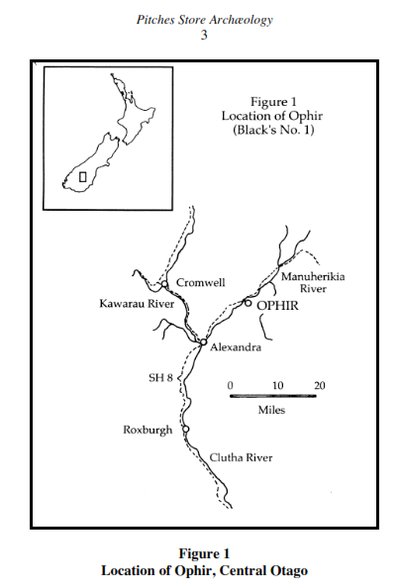 by COMB
by COMB
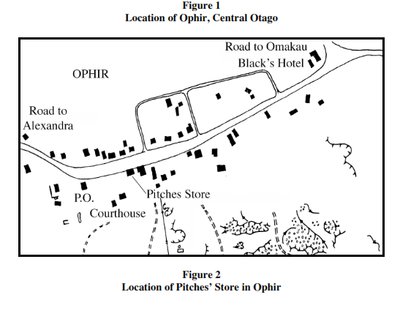 by COMB
by COMB
History of Ophir
The original European inhabitants of the Ophir area were Charles and William Black. The brothers held runs 226 and 244, bought for them by their father in 1857 (Cyclopedia of Otago 1996: 623; Beattie 1979: 323-324). They established a homestead and had over 20,000 sheep on the run by the time gold was discovered (Cyclopedia of Otago 1999: 623).
Gold was found near the homestead in April 1863, and a rush ensued to the new field (AJHR 1863 D6: 6). Within three months over 1,000 men were working there. The area was known initially as “Black’s,” and later as “Black’s No. 1,” as two nearby fields were also worked (Black’s No. 2 and Black’s No. 3). By 1865 a substantial settlement had grown up, with four stores, four public houses, two banks, a cottage hospital, a police station, a courthouse and Catholic and Presbyterian churches (Cyclopedia of Otago 1999: 622). The name of the settlement was changed to Ophir in about 1871 (Ng 1993: 278), although “Black’s” has continued to be used in some situations: the local hotel is still called “Black’s Hotel.” Figure 3 shows part of the 1871 plan of the Township of Ophir (S.O. 14701), showing how a series of buildings lined the main street. It also shows the tailrace reserves than ran through the middle of the settlement from the gold workings on the hillside behind the town.
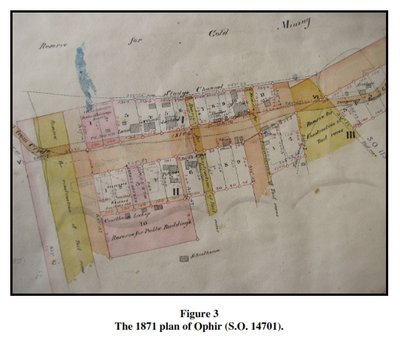 by COMB
by COMB
The mining at Black’s No. 1 was mainly alluvial, although some shafts were dug near the township, the 1887 Handbook of New Zealand Mines referring to Green’s Reef (or ‘Captain’s Reef’) within about 30 chains of the Ophir Township, at the head of Specimen Gully. It goes on to relate Professor Ulrich’s observations, including a reference to three shafts “sunk by former prospectors” on a ridge top (Handbook of New Zealand Mines 1887: 73-74).
The alluvial mining would initially have been undertaken by individual miners with shovels and pans. As late as 1887, long after the initial rush, 25 men were still “doing very well” at Black’s with “pick, shovel and cradle” (Handbook of New Zealand Mines 1887: 71). By early 1865 some 16 miles of water races had been constructed in the area (AJHR 1865 C4A: 14) to supply water for more efficient mining.
In common with many other Otago and Southland goldfields, the Chinese had a significant presence at Black’s No. 1, working ground that had been abandoned by European miners. From 1873 the Chinese outnumbered the Europeans, there being 170 Chinese and 30 European miners working the field in 1875 (Ng 1993: 277-278). It was the presence of large numbers of Chinese (up to 260 men) at Black’s No. 1 that revived the nearly deserted field, encouraged the building of substantial business premises, and encouraged the return of European miners (Ng 1993: 229). The Chinese began to leave the area in large numbers in 1879 (Ng 1993: 278).
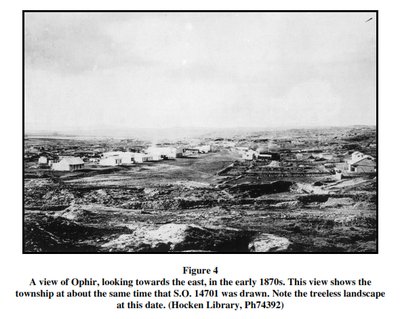 by COMB
by COMB
History of Pitches’ Store
John Pitches arrived in New Zealand from Victoria in 1862. He first set up a store at Alexandra, but probably soon moved on to Black’s. There he also opened a store, with his brother Samuel driving a team of horses between Dunedin and Blacks bringing goods inland, and sending back gold and cash. The money was hidden inside the horse collars to protect against theft (Otago Witness, 19/7/1905: 14).
Pitches’ store, on Section 5 Block II Town of Ophir, is shown on the 1871 plan of the town (S.O. 14701, see Figure 3). The Crown Grant (15/116) for Section 5 was issued to John and Samuel Pitches (storekeepers of Ophir) in April 1873, and the neighbouring Section 4 was purchased by John Pitches in 1885 (67/90). However, it is almost certain that the Pitches were in possession of the site before the date of the Crown Grant, and it is highly likely that this was the site of their store from the early 1860s.
The 1871 town plan (see Figure 5) shows two buildings on Section 5, annotated “Pitches,” confirming that the brothers did have a business premises on the property at that date (the calligraphy is consistent with other parts of the map, suggesting that the name was placed there at the time the map was drawn, and not added later). However, the plan shows the main building to be at an angle to the surveyed street, while the building that exists today (2008) is square to the section boundary.
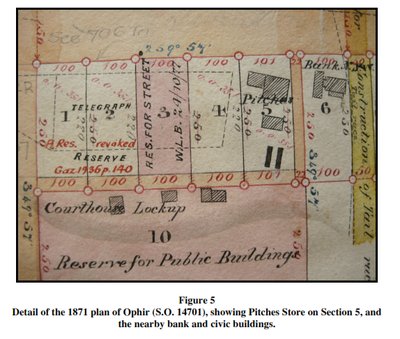 by COMB
by COMB
When the 1870s view of Ophir (Figure 4) is examined closely (the copy held by the Hocken Library was viewed using a magnifying glass) many of the buildings shown in the 1871 map can be identified. The building that is almost certainly Pitches’ Store is on the right hand side of the road, and appears to be at the angle as shown in the map. This would therefore indicate that the building that stands today is not the original building, and the commonly accepted pre-1871 date of construction is wrong. It is much more likely that the first Pitches’ Store was built of timber in the 1860s, and that this was replaced by a more substantial stone building sometime after 1871. The old building was roughly aligned towards the road, but the new building, built after the town was surveyed, sat square facing the road reserve.
It is of interest that one photograph of Pitches Store (Figure 6) has the words “John Pitches, Established 188?” visible above the door (unfortunately this is not clear in the reproduction here). As it is known that the Pitches were in business long before this date, it could refer to the date that the new store was built, or to the date that John Pitches became the sole proprietor of the business.
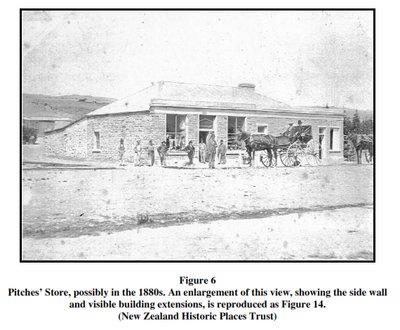 by COMB
by COMB
Examination of Figure 6 also suggests that the store frontage was extended at some stage, as a clear break in the parapet can be seen half way along. It is most likely that the left hand section of the building was constructed first, with a central door and two large shop windows, and the right hand section was added later. Two extensions to the rear are also visible, these being the subject of the 2011 archæological investigation.
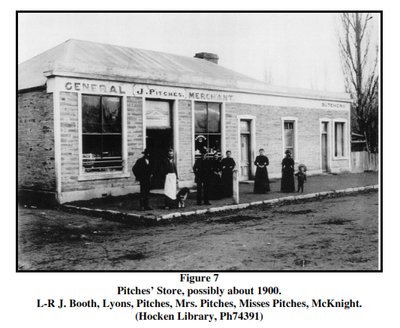 by COMB
by COMB
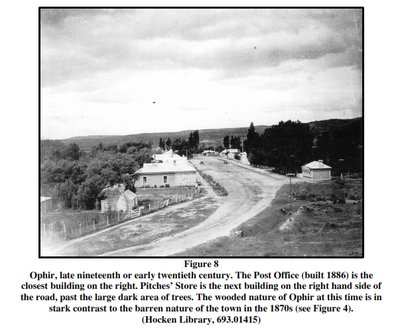 by COMB
by COMB
The subsequent history of the store is discussed by Leask (1998: 56-57). John Pitches left the property to his son Andrew when he died, and Andrew Pitches in turn left it to Elizabeth Sinnamon. The next owner was Ewan McPhail, who used the building as a wool and skin store. Russell Craig then used the store as a garage for his passenger bus, and he had the large doors cut into the main façade to allow the bus to enter. Russell Hayes then continued to use the building as a garage. Since Russell Hayes sold the building it appears to have had little use.
Site Description
The site prior to redevelopment consisted of the stone store building on a large grassy section, fronting the main street of Ophir. The section is roughly flat at the front, and then rises to the rear. The original stone store building measures 19.61 metres by 9.77 metres. It is situated on the east side of the property (i.e., on section 5), although the east wall is actually over the original boundary line. Behind the store building was an area of level ground approximately 11 metres deep, which is where the lean-to structures visible in Figure 6 once stood. This was the area that was investigated in June 2011.
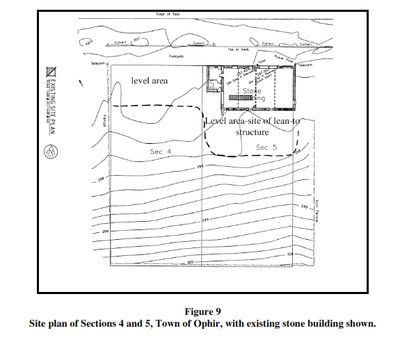 by COMB
by COMB
The stone store building itself has been modified on a number of occasions. The entire roof structure has been replaced, and a large garage door was cut into the front wall in the 1950s (see Figure 11). This removed the original store door and one large store window. The western end of the building (the old butchers shop end) remains relatively intact. All of the door and window fittings have been replaced. Internally the building has been largely gutted, and a large vehicle inspection pit has been dug into the floor.
The rear wall (Figure 16) of the building is stone, and is probably largely the original rear wall of the 1870s or 1880s main building. The east side wall (Figure 12) is original, and still has traces of the original plastered finish with raised pointing. The window aperture in this wall is also original, although the fittings are not.
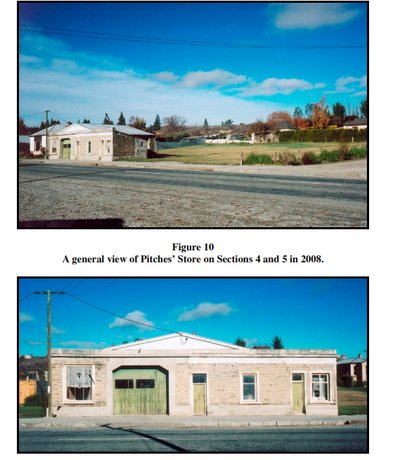 by COMB
by COMB
 by COMB
by COMB
Figure 13 The west wall of Pitches’ Store in 2008.
Building Modifications Over Time
Of particular interest for the archæological investigation was the evidence from historic photographs that the Pitches’ Store has been extended several times, with several additions to the rear that were no longer extant by the late Twentieth Century. The first addition was probably an extension to the street frontage, visible in early photographs (see Figures 6 & 7). This was followed by two extensions added to the rear of the store (See Figure 14). These rear additions can be seen in the slight changes in the stonework, and in the changing roof pitch: each change in the pitch indicates a separate building event. By 2008 only the main building (original frontage plus extension) survived, but the 2011 archæological investigation found evidence of the ‘missing’ rear additions, together with a previously unknown addition.
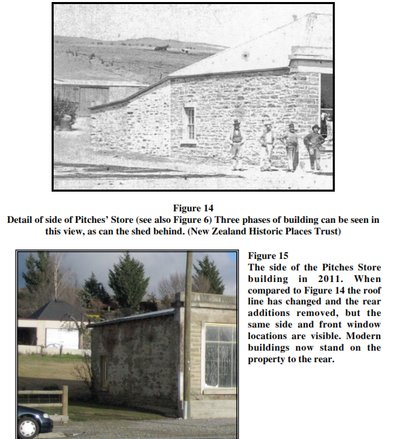 by COMB
by COMB
Archæological Excavation
The archæological excavation was undertaken from the 20th to the 22nd of June 2010. It was carried out by Peter Petchey, Andrew Brown and Jitlada Innanchai, with the assistance of an hydraulic digger driven by Garry Croy. The initial excavation strategy was to examine the level area to the rear of the existing stone building, where it was known that stone additions had once stood, and where the new building construction is to take place (Figure 16).
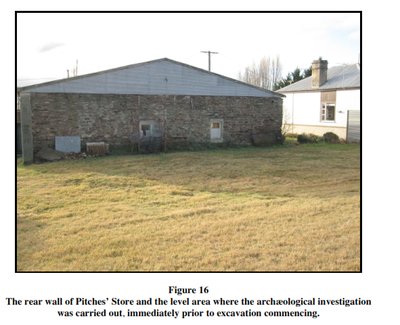 by COMB
by COMB
Excavation commenced by running a string line out behind the existing building in line with the eastern wall, and placing small hand-dug test excavations along this alignment to attempt to find the foundation walls of the ‘missing’ section of the building. Measurements were taken from the historic view of the store (Figure 14) in an attempt to relocate the corners of the two known rear building extensions. These corners were quickly found, and the remains of foundation walls up to 0.6m high buried by schist rubble and earth were uncovered (Figure 17).
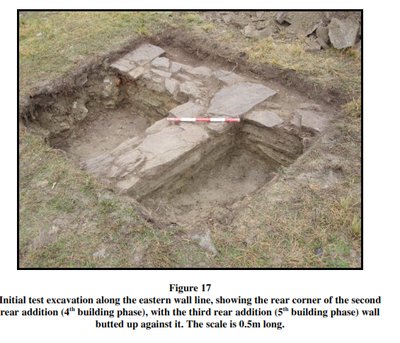 by COMB
by COMB
Once the locations of the main wall lines had been established, the hydraulic digger was used to remove the overburden along these lines to expose the surviving foundations. The outlines of the two known rear extensions to the building were identified, and a previously unknown third extension was also found. These structures represent five building phases (the original store building and four additions), which are shown in Figure 18.
Several areas within the foundations were then cleared out down to the original floor/ground levels, and the area to the rear of the original building footprint was also excavated to attempt to identify any features in this area. The excavation was divided into 5 Areas, based on areas within the foundation footprint. These Areas (and the corresponding building phases) are summarised in Table 1, and shown in Figure 18.
Table 1 Summary of excavation areas
 by COMB
by COMB
Figure 18 Excavation plan of Pitches’ Store site, showing the existing stone structure together with the stone wall foundations uncovered during the 2011 archæological investigation. The excavation Areas are labelled, together with the five identified building phases. The sequence of the small westward extension to the frontage is not known.
The general site fill throughout the excavation was a mixture of soil and schist building rubble, with some artefactual material. It appears that the stone additions to Pitches’ Store collapsed or were demolished in on themselves and the rubble then levelled off, rather than the building stone being removed from the site. The discovery of several forged iron top plate anchors (used for securing timber top plates to stone walls) within the rubble confirms this interpretation. The wall foundations that were exposed stood to a maximum of 0.6m high at the rear of the site, where the building had been dug into the gently rising ground.
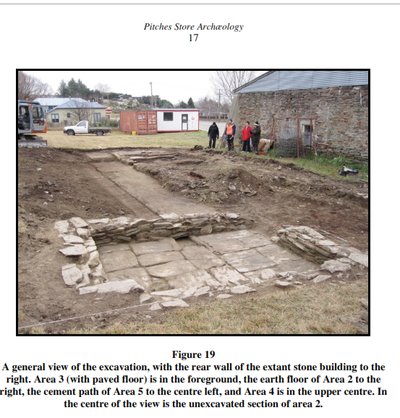 by COMB
by COMB
Area 1
Area 1 was the area of the first rearward extension of the original stone store building (Phase 3). The wall lines were exposed, but the interior was not excavated (it was immediately adjacent to the stacked stone rear wall of the standing building). The foundations were stacked schist, 0.6m wide at the sides and 0.45m wide along the rear wall. The extension was 16.6m wide (the same width as the extant building) and 4.2m deep. Figure 23 shows a detail of the south-eastern corner of this part of the structure.
Areas 2 & 4
Areas 2 and 4 were the second addition to the building (Phase 4). This extension was the same width as the extant building and 4m deep. The wall dimensions were the same as for Area 1, ie up to 0.6m thick side walls and 0.45m deep rear wall.
Area 2 was the eastern part of the Phase 4 extension. It was separated from Area 4 by an internal stone cross wall, on the east side of which was the partial remains of a cement floor. Approximately half of Area 2 was excavated down to ground level. The floor was of trodden earth with numerous ceramic sherds, glass bottles and glass fragments. There were also some parts from a cast-iron range. There was no evidence of a timber floor having been installed in this area, and the earth floor level was the same as the schist paved floor in Area 3 (see Figure 21).
Area 4 was the western part of the Phase 4 extension, and measured approximately 5m by 4m. An external doorway opened out onto the rear cement path (Area 5). This Area included a stone, cement and brick foundation (Figure 20) that is interpreted as the setting for a coal range. There is evidence of a destructive fire in this area, with melted glass and shattered, scorched ceramics present on the earth floor. This floor level was below that of the cement and brick setting and the doorway, making it likely that there was originally a wooden floor in this area.
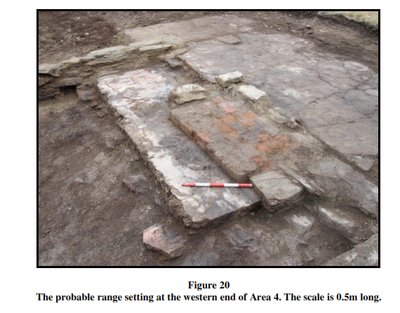 by COMB
by COMB
Little remained of the rear wall of Area 2 (shown with dashed lines in Figure 18). It is possible that the extensions were flattened off using a bulldozer or other machine at some stage, and the middle part of the rear wall was destroyed then.
Area 3
Area 3 was the final rearward extension to the building (Phase 5). The structure consisted of a small stone-walled extension that measured 4m by 3.5m, with a flagged stone floor (Figures 21, 22, 23), out of which ran a drain (Figure 24) that continued across Area 5. The walls were not as well constructed as the Phase 1, 2, 3 and 4 walls, although the flagstone floor was well made with large trimmed schist slabs. A doorway connected Areas 2 and 3, but there is no evidence of there having been an external door into Area 3.
In the south-east corner of Area 3, built into the corner of the wall, was the remains of a fireplace (Figure 25). This consisted of a red brick setting with iron firebars. The location of the chimney could be identified by the black soot stain mark up the wall (Figure 25). Given the presence of the stone floor and large drain, it is likely that this extension was built as a wash house, and the fireplace was the setting for a laundry copper.
The Area 3 stone floor was not lifted, but was left in place to be incorporated into the new building development.
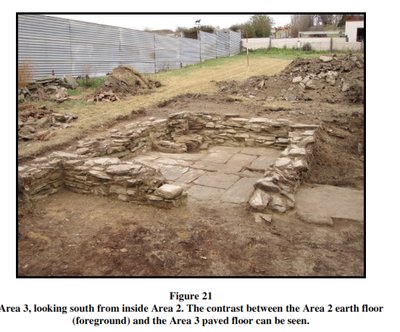 by COMB
by COMB
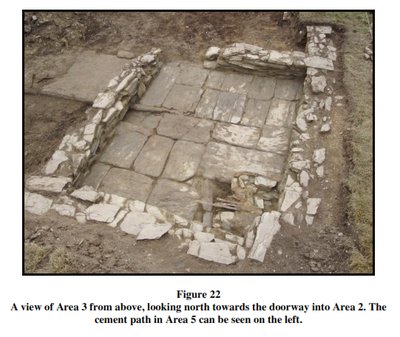 by COMB
by COMB
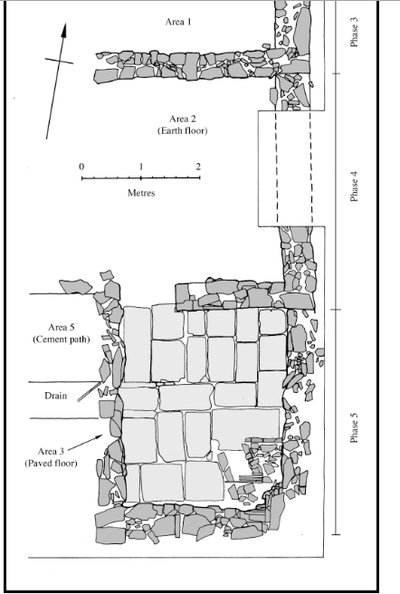 by COMB
by COMB
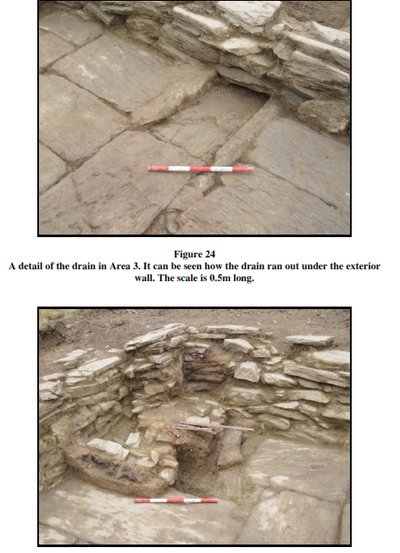 by COMB
by COMB
Figure 25 A detail of the fireplace in the south-east corner of Area 3. This was probably the setting for a laundry copper. Note the soot staining on the wall where the outline of the chimney can be seen. The scale is 0.5m long.
Area 5
Area 5 was the area of the cement path and drain to the rear (ie outside) of the building footprint (Figure 26). The cement path ran along the length of the rear wall of the store and around the western end. There was a single step up near its western end. Schist slabs on their sides were used to edge the path. This path must have been constructed after all of the main building phases.
The drain from Area 3 ran underneath the wall and alongside the path. It was an open cement- lined channel with a shallow dish to the base.
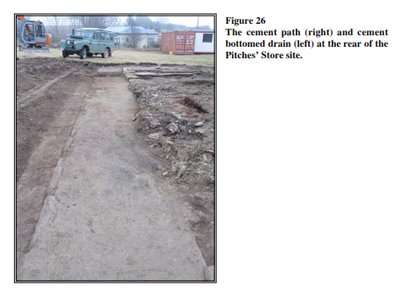 by COMB
by COMB
Artefact Analysis
Artefactual material was recovered from all of the areas investigated. This material fell into four main categories: glassware, ceramics, metalware and faunal (bones). This discussion considers each of these material classes in turn.
Glassware
The glassware consisted mainly of bottle glass (both complete and broken bottles), together with some drinking glasses, a small amount of ornamental glass (probably from vases), and window glass. The minimum number of vessels (MNV) for the assemblage was calculated by counting bottle tops and bottle bases, and then taking the greatest total. This method allows both complete and broken bottles to be taken into account (a complete bottle has a top count and base count of 1). There were 21 bottles and jars represented, of which 12 were complete. Most of the complete bottles were found in Area 2, with just one complete pharmaceutical bottle (middle in Figure 27) being found in Area 4. This complete Area 4 bottle was unexpected, because most material from this area was badly fire-damaged (see Figure 30). All of the bottle tops from both complete and broken bottles were machine-made, indicating a twentieth century date of manufacture of all of the bottles. No hand-made applied tops or hand-made bottles were present, these being indicative of nineteenth century manufacture.
Of the complete bottles, the majority were of forms that can be associated with household, pharmaceutical or cosmetics contents. None had any surviving labels, and only two were embossed to identify their original contents, these being “Q-TOL FOR SKIN COMFORT” and “SLOAN’S OINTMENT” bottles (see Figure 27). Q-Tol and Sloan’s Liniment were both advertised as ointments in the early- and mid-twentieth century, and Sloan’s Liniment is still available today. Q-Tol was a skin ointment advertised as being suitable for sunburn, rashes and other skin irritations, and Sloan’s ointment was used for temporary relief of muscle or joint pain (Figure 28).
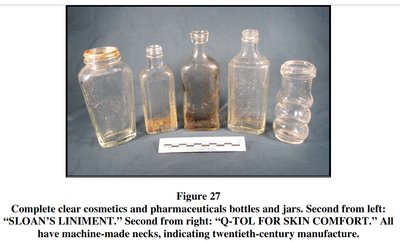 by COMB
by COMB
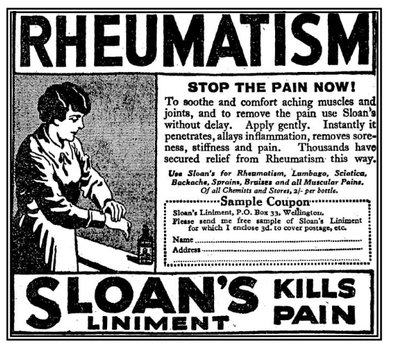 by COMB
by COMB
Figure 28 Advertisement for Sloan’s Liniment (NZ Truth, 8 May 1930: p18).
A third bottle was embossed “NOT TO BE TAKEN” (see Figure 29), and would have contained a poison or non-consumable household product. It was brown, with an octagonal shape and vertical striated pattern that was commonly used on poisons bottles so that they could be readily identified by feel (Tasker 1984: 37).
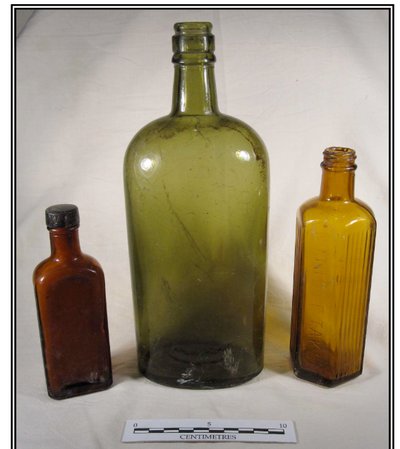 by COMB
by COMB
Figure 29 Complete brown and green bottles. Left: brown pharmaceutical or household bottle. Centre: green spirits bottle. Right: brown household or poison bottle, embossed “NOT TO BE TAKEN.” All have machine-made necks, indicating twentieth-century manufacture.
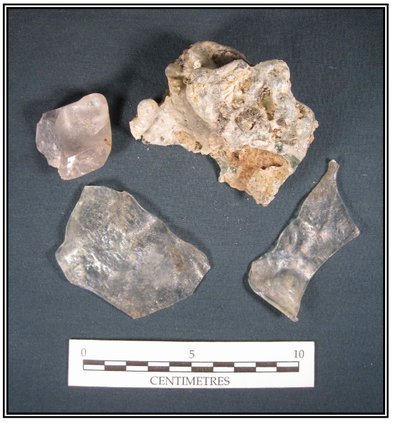 by COMB
by COMB
Figure 30 Melted glass from Area 4. The lump at top right has completely melted and its original form is not identifiable. Top left is a heat-deformed fragment from a shattered drinking glass, and at bottom are two deformed fragments of window glass.
Generally the glassware assemblage represents domestic use in the mid-twentieth century. Three or four alcohol bottles were greatly outnumbered by various household bottles, including the two identifiable liniment or lotion bottles. In common with other artefact classes and other archæological evidence, the glassware assemblage shows that a destructive fire took place in Area 4, but did not extend into the rest of the investigated portion of the building.
Ceramics
The majority of the ceramics recovered were fragmented domestic wares (cups, saucers, bowls), together with parts of two stoneware flagons. Non-tableware items were a clay pipe and a small figurine. Most of the ceramic material found in Area 4 was fire-damaged, with discolouring, heat fracturing and glaze melting/damage. By contrast, the ceramics from Areas 2 and 3 showed no such damage. However, cojoins (fragments that fitted together) were found in Areas 2 and 4, and Areas 2 and 3, suggesting that at least some of the assemblage was broken and deposited at the same time.
The vessels were counted by determining the MNV (Minimum Number of Vessels) by sorting the fragments by body-type (earthenware, vitrified, stoneware), vessel form and pattern, and then determining how many vessels were represented within each grouping by comparing details such as body thickness and the presence of rim fragments. A total of 365 fragments were counted, which represented 51 vessels. Most of these were found in Area 2 (MNV=27) and Area 4 (MNV=16). The most common type of vessels were plates (including saucers) (MNV=24) and cups (MNV=13). Table 1 summarises the numbers and distribution of these vessels.
 by COMB
by COMB
Table 1 Basic distribution of ceramic vessel forms
Most of the plates and cups had plain white bodies, with a number of variations on gold or green stripes around the rims. One matching set of items with a plain white body and overglaze green and gold stripes and floral motifs was found, manufactured by Victoria China of Czechoslovakia (Figures 32 & 46). Only four under-glaze transfer print (UGTP) decorated tablewares were found, one example of ‘Teddesley’ (Figure 32) a fragment of ‘Blue Willow,’ several fragments of ‘Hawthorn’ (Figure 33) and a Spode ‘Jacinth’ plate (Figure 34). UGTP designs are common in late nineteenth century historic archæological sites, but of the vessels from the Pitches’ Store site only the ‘Teddesley’ plate was probably of this period.

Figure 31: White Royal Albert Crown China cup from Area 2. Right: White earthenware cup with four gold rim stripes (largely worn off) from Area 3.
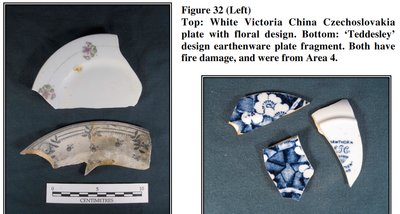 by COMB
by COMB
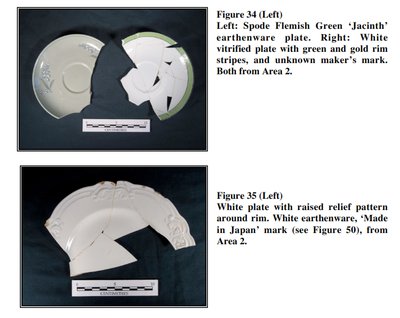 by COMB
by COMB
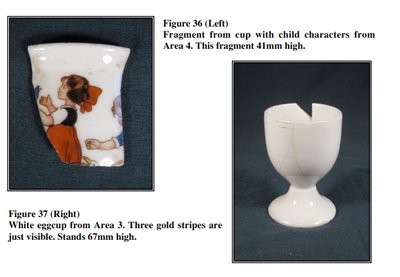 by COMB
by COMB
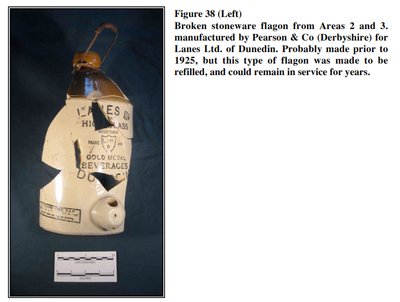 by COMB
by COMB
Ceramic Makers’ Marks
The makers’ marks applied to ceramic vessels are one of the best ways to determine the likely manufacturing date range for those vessels. At the Pitches’ Store site seven manufacturers could be positively identified, of which six were British and one from Czechoslovakia (now the Czech Republic). In addition there was a ‘Made in Japan’ mark that could not be attributed to any particular company. Below are illustrated the marks that were found, together with details of the relevant manufacturers.
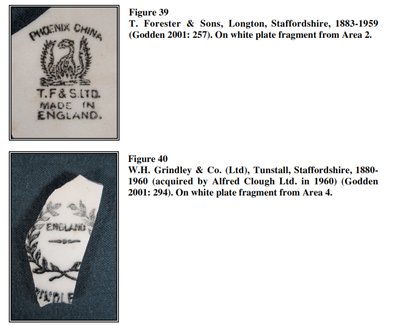 by COMB
by COMB
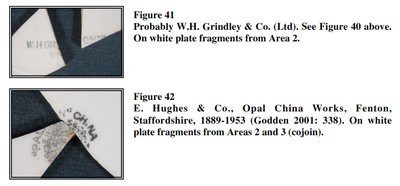 by COMB
by COMB
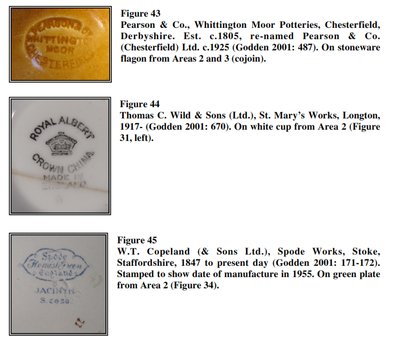 by COMB
by COMB
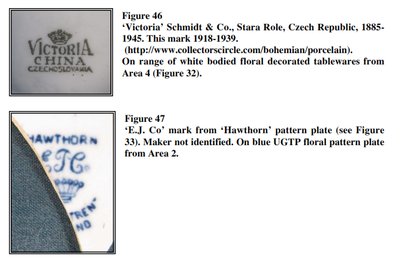 by COMB
by COMB
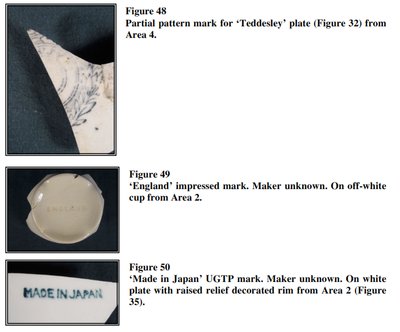 by COMB
by COMB
 by COMB
by COMB
Of the marks that could be confidently assigned to a date range, all included the early twentieth century period, while several were only produced during the twentieth century (such as the Czech Victoria China and Thomas Wild Royal Albert Crown China). The Spode plate bore a 1955 manufacturing stamp, effectively providing a terminus ante quemfor the abandonment of the rear section of the building. The evidence of fire damage on virtually all of the ceramics from Area 4 support the suggestion that they were in the building during a large fire that was seated in that area.
In general, the vessel forms from the Pitches’ Store site are typical of domestic assemblages, with plates and cups the most common vessel types. The Lanes’ flagon is also not uncommon. However, the pattern types and manufacturing origin (as identified by makers’ marks) were unusual for a Central Otago historic archæological site, as there were few of the usually common UGTP patterns, and European and Japanese makers were represented as well as British companies. This is a result of the age of the assemblage. Most sites that are investigated date to the late nineteenth century, but the makers’ marks show that Pitches’ Store assemblage dates to the middle of the twentieth century, when the store was damaged by fire and its domestic accommodation role ceased. In this period a wider range of items from countries other than Britain were entering the market.
Clay Pipe
Only one clay tobacco pipe was found during the Pitches’ Store excavation (Figure 52). This was a broken bowl (reconstructed for the photograph), with the stem missing. The bowl was marked ‘BEN NEVIS CUTTY’ which was the name of the style. The maker’s name, which would have been impressed on the stem, was missing. This type of clay pipe is commonly found in New Zealand historic archæological sites (eg. the Farmers site in Dunedin, Petchey 2004: 55).
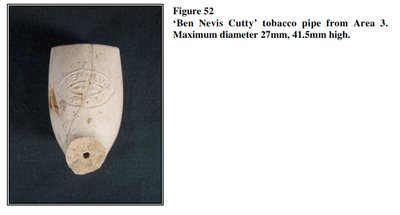 by COMB
by COMB
Ceramic Figurine
A small porcelain figurine was found in Area 4 (Figure 53). This portrayed a small child in a large bonnet, and stood 67mm high. This had some glaze damage and some slight damage to the feet due to exposure to a fire.
 by COMB
by COMB
Figure 53 Porcelain figurine from Area 4. Stands 67mm high.
Metalware
There was a large amount of metalware (predominantly cast iron) found in the Pitches’ Store site. This fell into several broad categories: machinery parts, coal range parts, tools, smaller household items, and structural items.
A large number of broken up cast iron machine parts were found in Area 3, including numerous parts of a large drive cog and parts of a machine frame. This material was mixed with the building rubble, but was concentrated in the lower layers of this. It is likely that this material was deposited in the building during its collapse/demolition, as no evidence was found of machine footings on the Area 3 stone floor, and the present (2011) owner of the neighbouring property, Bernie Allen, reported that a previous owner of that property had hoarded scrap iron. This material therefore probably does not relate to the occupation of Pitches’ Store, but rather to a dumping event during the building’s demolition/collapse.
There were numerous sections of broken-up cast iron coal range, particularly in Areas 2 and 3. Some of this material was mixed in with the building stone rubble, and so was possibly deposited along with the machinery parts discussed above, but some was below this rubble on the floors of the two areas, suggesting that it was deposited immediately prior to the demolition or collapse of the stone walls. One fragment was embossed with a maker’s mark: “SR & Co. 257 & 259 WATER ST. N.Y.” (Figure 54) this being Southard, Robertson & Co. of New York, which was a late nineteenth century stove manufacturer. Another fragment was embossed “ENCHANTRESS” which was presumably the stove model name.
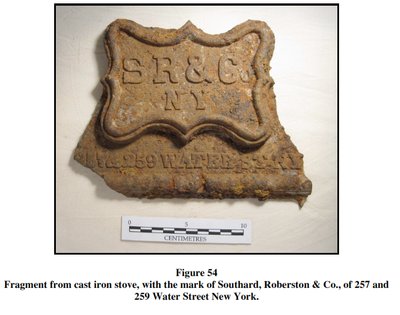 by COMB
by COMB
 by COMB
by COMB
Figure 55 Ornate cast iron door from coal range, found on the earth floor in Area 2.
The tools consisted of three metalworking files and a heavy chisel. Two of the chisels were flat and one triangular in section. The files were found in Area 4 (probable kitchen) and Area 5 (rear outside path), while the chisel was found in Area 3 (rear paved room).
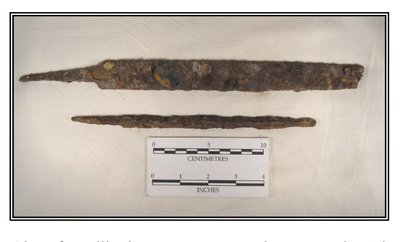 by COMB
by COMB
Figure 56 Two files from Area 4. The top file was flat in section, the bottom was triangular. Both were heavily corroded.
Also of a utilitarian nature was an almost complete gin trap, with just one jaw missing. Although corroded, this was in reasonably good condition. It was found in Area 3. Gin traps are commonly seen throughout Central Otago, even today, because of the rabbit nuisance.
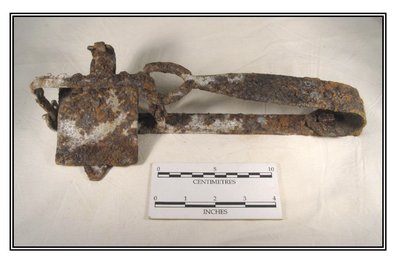 by COMB
by COMB
Figure 57 Gin trap from Area 3.
A small geared device (Figure 58) was found in Area 5 (footpath), just outside Area 4. This was deformed and corroded, but appeared to consist of a geared drive wheel with a hand crank, which drove several other shafts. It might have been in the kitchen during the fire, as it appears to have been fire-damaged.
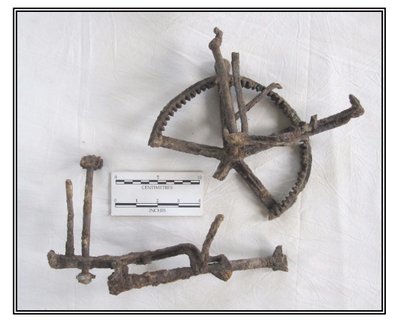 by COMB
by COMB
Figure 58 Remains of mechanical remains from Area 5.
Household items included a table spoon and several forks, all found in Area 4. One fork was stamped “PROPERTY OF N.A.C.B.” The presence of these items strengthens the argument that this was a kitchen area. Also found was an aluminium “STERADENT’ denture cleaner tin and a brass coat hook, both from Area 2.
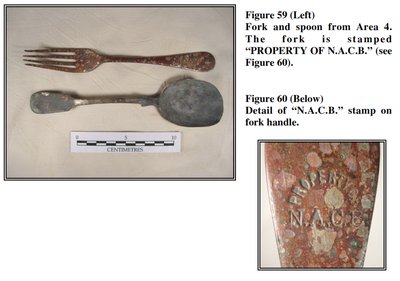 by COMB
by COMB
The structural components were three inverted-T shaped wrought iron brackets designed to be built into the top of a stone wall and to hold down a timber top plate for the roof frame. The presence of these in the general schist wall rubble suggests that the complete walls were demolished and levelled off.
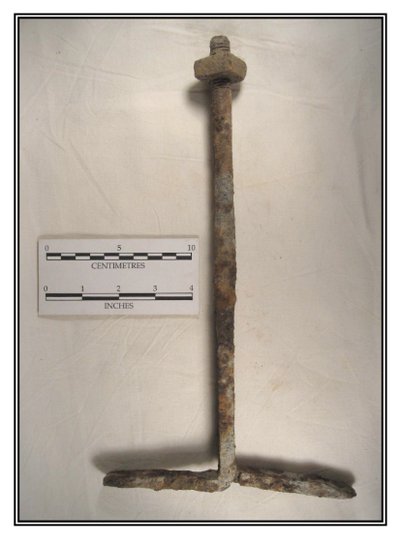 by COMB
by COMB
Figure 61 Iron bracket for securing timber plate to top of stone wall. The arms at the bottom would have been built into the top few courses of stone, leaving the threaded rod sticking out of the top of the wall. A timber plate could then be bolted down to the wall, and the rafters for the roof structure nailed to that plate.
Faunal Material
The faunal material (bones) from the Pitches’ Store site consisted of the remains of cattlebeast, sheep and rabbit. The rabbit bones included a skull, parts of two pelves and two femora, and were from animals that had burrowed into the site after its demolition and died naturally, rather than animals that had been killed and butchered for their meat. The sheep bones included several limb bones (a humerus, femur and metacarpus) that showed no butchery marks, so could have been parts of natural carcasses (not unexpected in a largely rural setting like Ophir), but one vertebra fragment had been both chopped and sawn. Similarly, the cattlebeast bones included a femur with no butchery marks, but a second femur had been sawn off near its proximal end. A cattlebeast ilium had been sawn off the rest of the pelvis (absent), and bore numerous cut marks across its surface.
This assemblage indicates that rabbit was present as part of the local fauna (as also evidenced by the gin trap found on the site, discussed above), but no evidence of the consumption of rabbit meat was found. Sheep and cattlebeast were also present, and there is good evidence that they were butchered and consumed. The absence of dog gnawing on any bones suggests that the meat was butchered for human consumption.
Discussion
The archaeological investigation of the rear of Pitches’ Store revealed a great deal of detail about the final late nineteenth and early twentieth century form of the building, confirming information gleaned from contemporary photographs, and adding details not previously known. Most significantly, a third rear addition to the rear of the building was found that does not appear on any photographs located to date. The evidence for a setting for a laundry copper, the stone paved floor and the substantial drain all suggest that this extension was constructed as a wash house.
The previous two rear extensions to the original store building were known to exist, but their exact extents have now been determined, and the archaeological evidence confirms that they were built at different times, with the walls of each extension being butted up against the rear of the previously built structure. Each extension extended back approximately 4m (a nominal 13 to 14 feet), with the first and second rear extensions being the full width of the main building (excluding the Butcher’s Shop frontage to the west), but the third extension was only 3.7m (12ft) wide. The fact that the two rear extensions were the same width as the original store front plus the extension to the west indicate that this extension to the frontage of the building was constructed before the rearward extensions.
The first and second rear extensions were presumably at least in part living quarters, this suggestion being supported by the archaeological evidence. The western end of the second addition (Area 4) included the brick and cement hearth for a coal range, and had evidence that there was a wooden floor in this room. The hearth remains together with cutlery (forks and a spoon) and ceramics found in this area suggest that Area 4 was the kitchen. This room also contained evidence of a destructive fire, with lots of charcoal being present, together with melted glass and scorched ceramic fragments. The other areas excavated had much less evidence of this fire, so it appears that it originated in, and caused most damage in, the kitchen.
The artefactual material recovered from the site was all from scatter deposits within and underneath the building rubble, and no stratified pit features were found. The majority of identified material appears to be of mid-twentieth century origin, and therefore can be associated with the final use and subsequent abandonment/destruction of the rear section of the building. The evidence of the fire in the south-western part of the building might explain this partial abandonment and demolition. A small amount of possible late-ninteenth century ceramics were found, but ceramics can be curated1 and it is likely that this material was discarded at the same time as the rest of the assemblage.
It is interesting to note that the usual pattern of use of almost exclusively British ceramics seen in nineteenth century archaeological sites in Otago is not seen here: Japanese and Czechoslovakian ceramics feature also in the assemblage. This shows how markets were changing during the twentieth century, with imports coming from new sources as well as the traditional British manufacturers.
With regard to accurately dating the various phases of construction and subsequent partial demolition, some informed conclusions can be made. As discussed in the initial archæological assessment (Petchey 2008), the Pitches’ Store business was probably established in the early 1860s, but the first part of the existing store was built at some time between 1871 and the early 1880s, replacing an earlier structure. The first two of the three stone additions at the rear of the store are shown on a nineteenth century photograph (Figure 6), but the third addition (Area 3) is not present.
[1 Items that are curated are deliberately kept and can remain in use for many years after their initial manufacture date.]
The timing of this addition is therefore unknown. No artefactual material that might date it was found, and the stone floor was not lifted, but was left in place to be incorporated in the new building development. The nature of construction, with stone paved floor and rough stacked stone walls, could belong to either the late nineteenth or early twentieth centuries. The partial demolition of the buildin[g probably occurred after a fire damaged part of the structure. Local knowledge (L. Galer, C. Hurd, pers. comm. 2011) is that a fire did damage the building, but no-one knows the date of this fire. The archæological evidence is that this fire was seated in what was probably the kitchen, at the south-west rear corner of the building, and was hot enough to melt glass objects in that room. The date ranges of the artefactual material that was affected by this fire indicates that it occurred after World War Two, possibly as late as the mid- to late-1950s.
In summary, the archæological investigation found evidence that the construction of the Pitches’ Store building occurred in at least five main phases during the late nineteenth (and possibly early twentieth) century, starting in the 1870s or early 1880s. The last phase was the addition of a small wash house at the rear of the building. While the front of the building was used as commercial premises, the rear section contained a domestic residence. This included a kitchen and the aforementioned wash house. At some date in about the middle of the twentieth century a fire started in the kitchen and completely gutted that room, destroying most if not all of its contents. It is not known how far the fire spread, although it is likely that it damaged the main roof structure which led to the building being re-roofed in a different profile to the original roof. While the front section of the store was repaired after the fire, the stone extensions to the rear, including the fire-gutted kitchen and the wash house, were demolished and the site levelled off. This was the final form of the building at the time of the 2011 archæological investigation, immediately prior to the restoration of the building.
References
Appendices to the Journals of the House of Representatives. 1863
Beattie, H. (1979) The Southern Runs. Times Printing Service, Southland Times, Invercargill.
The Cyclopedia of Otago (1999) Dunedin City Council.
Godden, G.A. (2001) Encyclopaedia of British Pottery and Porcelain Marks. 7th impression. Barrie & Jenkins Ltd., London.
The Handbook of New Zealand Mines 1887. Government Printer, Wellington.
NZ Truth (Newspaper, Wellington) 8 May 1930: 18 (accessed through www.paperspast.natlib.govt.nz).
Ng, J. (1993) Windows on a Chinese Past. Vol. I. Otago Heritage Books, Dunedin.
Otago Witness (Newspaper, Dunedin) 19 July 1905: 14 (accessed through www.paperspast.natlib.govt.nz).
Park, J. (1906) The Geology of the Area Covered by the Alexandra Sheet, Central Otago Division. New Zealand Geological Survey, Bulletin No. 2 (New Series). Govt. Printer, Wellington.
Petchey, P.G. (2004) “Beside the Swamp. The Archæology of the Farmers Trading Company Site, Dunedin.” Unpublished report by Southern Archæology Ltd.
Petchey. P.G. (2008) “Pitches’ Store, Ophir. Archæological Site G41/614. Archæological Assessment. Upublished report by Southern Archæology Ltd for Hurd Property Partnerships.
Tasker, J. (1984) Collecting Antique Bottles in New Zealand. A Guide for Beginners. A.H. & A.W. Reed Ltd. Wellington.
Maps & Plans
S.O. 14701 (Otago Land District) (1871) Plan of the Township of Ophir (Black’s). W. Arthur. (Land Information New Zealand).
Websites
http://www.collectorscircle.com/bohemian/porcelain/marks_table2.html
Appendix A
New Zealand Archæological Association Site Record Form
xx
Appendix B
Artefact Catalogue
xx
xx
xx
xx
xx
Discuss This Topic
There are 2 comments in this discussion.
Read and join this discussion
UnknownStranger
said .
Allowing guests to savor the sizzling, caramelized flavors accompanied by an array of banchan side dishes including kimchi and pickled vegetables cookingflavour.com Korean BBQ is a communal and flavorful feast that brings people together.

Yang ruflo
said Thank you
Awesome! Have they found any connections to this archaeological findings? I hope it is somewhat connected to great events before.
Yang, Auckland, www.commercialcleaningaucklandpros.co.nz/